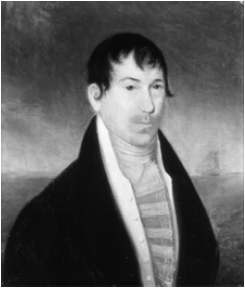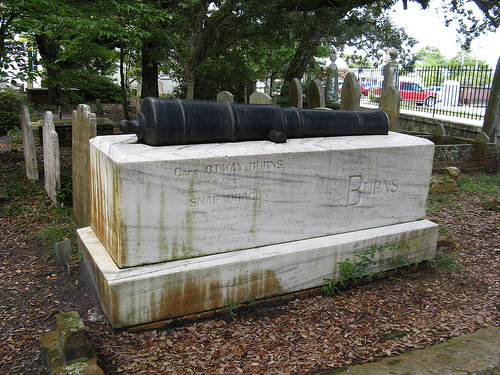Otway Burns
The Ups and Downs of a Seafaring Man
by RoAnn Bishop
Reprinted with permission from the Tar Heel Junior Historian, Fall 2008.
Tar Heel Junior Historian Association, NC Museum of History
 Like the sea he loved, Otway Burns’s life was full of rises and falls. The swashbuckling sea captain became North Carolina’s first naval hero during the War of 1812. Later he built one of the state’s first steamboats and served in the legislature. Yet he died poor and unnoticed, living his last years as a lonely lighthouse keeper on the Pamlico Sound.
Like the sea he loved, Otway Burns’s life was full of rises and falls. The swashbuckling sea captain became North Carolina’s first naval hero during the War of 1812. Later he built one of the state’s first steamboats and served in the legislature. Yet he died poor and unnoticed, living his last years as a lonely lighthouse keeper on the Pamlico Sound.
Born about 1775 in Swansboro on Onslow County’s White Oak River, Burns mastered seamanship skills at an early age and became a merchant captain. When the War of 1812 broke out, he and some business partners bought a fast Baltimore clipper ship and renamed it the Snap Dragon. They got a license to operate the Snap Dragon as a privateer—an armed, privately owned ship authorized by the government to attack enemy shipping.
Snap Dragon measured more than eighty-five feet long and twenty-two feet wide, and weighed 147 tons. It carried a crew of eighty to one hundred men and as many as eight cannons. Between 1812 and 1814, Burns commanded the ship on three wartime cruises. It sailed from Newfoundland, Canada, to South America, capturing more than forty British ships and their cargoes worth more than $4 million.
After the war, Burns used part of his privateering profits to open a shipyard in Swansboro. There, in 1818, on waterfront lot number six, he built one of North Carolina’s first steamboats, Prometheus. The paddle-wheeler traveled the Cape Fear River between Wilmington and Smithville (now Southport) for seven years, even carrying President James Monroe in April 1819 on a visit to inspect Fort Johnson. The vessel was abandoned in 1825, probably because its engine wasn’t as powerful as those of newer steamboats.
 After trying his hand at shipbuilding, Burns moved to Beaufort and dabbled in other businesses. But politics next grabbed his interest. A Democrat, he represented Carteret County in the state legislature from 1821 to 1835 (seven terms in the house and four in the senate).
After trying his hand at shipbuilding, Burns moved to Beaufort and dabbled in other businesses. But politics next grabbed his interest. A Democrat, he represented Carteret County in the state legislature from 1821 to 1835 (seven terms in the house and four in the senate).
Near the end of his political career, Burns suffered money problems. Having stressed his financial resources by investing in too many businesses, he had to sell most of his property to pay his debts. In 1836 President Andrew Jackson, another hero of the War of 1812, came to the aid of the near-destitute Burns. Jackson appointed him keeper of the Brant Island Shoal Light near Portsmouth. Burns died there on October 25, 1850—having outlived his three wives—and was buried in the Old Burying Ground in Beaufort. A cannon from the Snap Dragon rests atop his tomb.
Two North Carolina towns—Burnsville in Yancey County and Otway in Carteret County —were named for Otway Burns, as were two U.S. Navy destroyers during the first half of the 1900s. And there are two places in the state where statues still preserve the likeness of the scrappy, if somewhat delicate-looking, captain: one in Burnsville’s town square and one in Swansboro that overlooks the sea. Burnsville was named for Burns because, in 1835, he supported western North Carolina’s efforts to get more representation in the General Assembly. The easterners he represented voted him out of office.
RoAnn Bishop is the curator of agriculture, industry, and economic life at the North Carolina Museum of History.
Image Credits:
An oil painting of Otway Burns by F. Mahler, ca. 1875-1895. Image courtesy of the North Carolina Museum of History.
Underhill, Michelle. "Otway Burns tomb." The Old Burying Ground, Beaufort, N.C. August 23, 2012. https://www.flickr.com/photos/mczu/7864005476 (accessed August 27, 2012).
1 January 2008 | Bishop, RoAnn